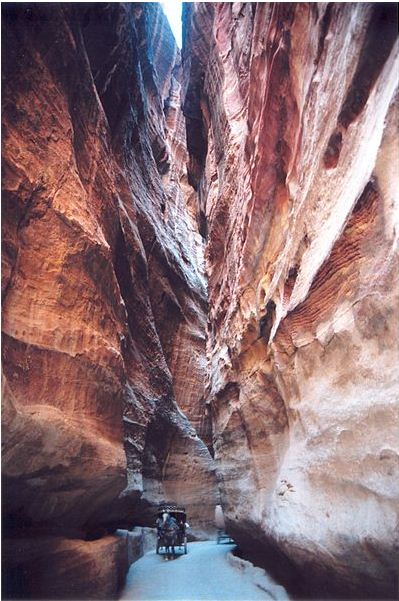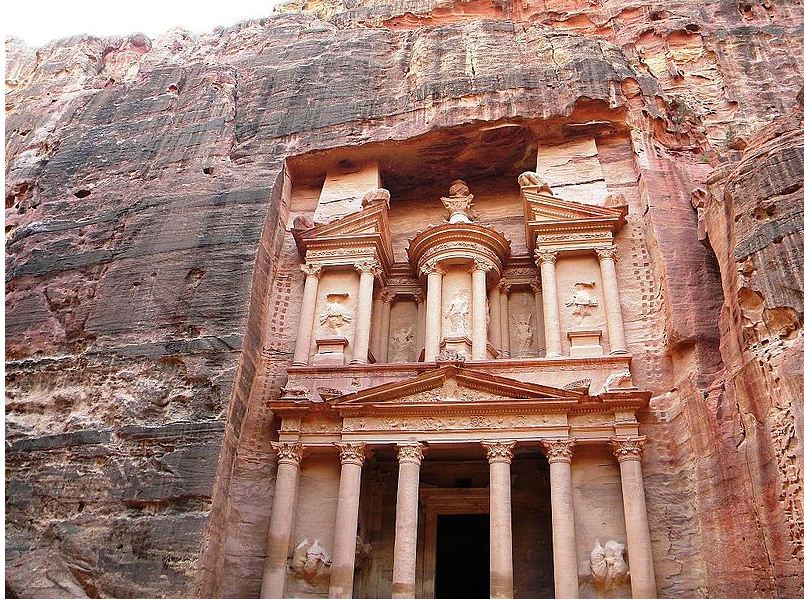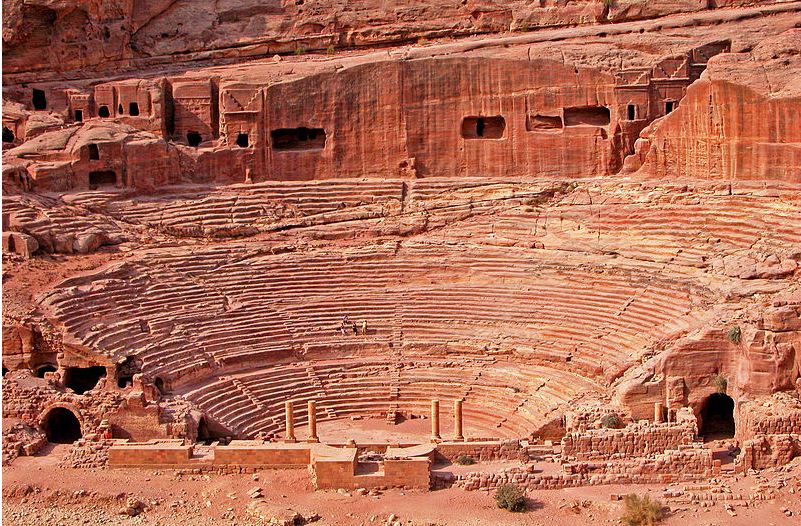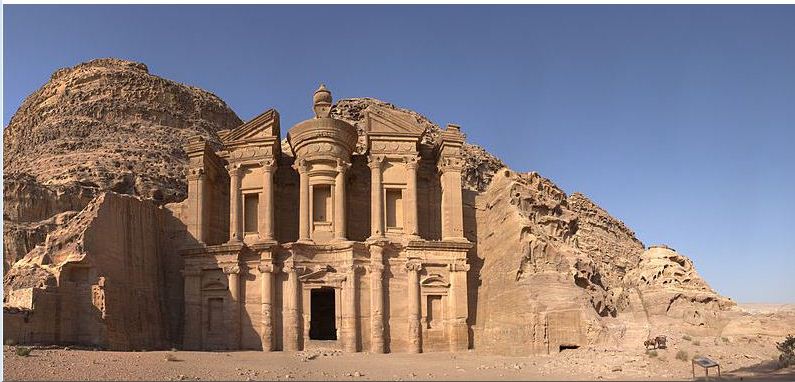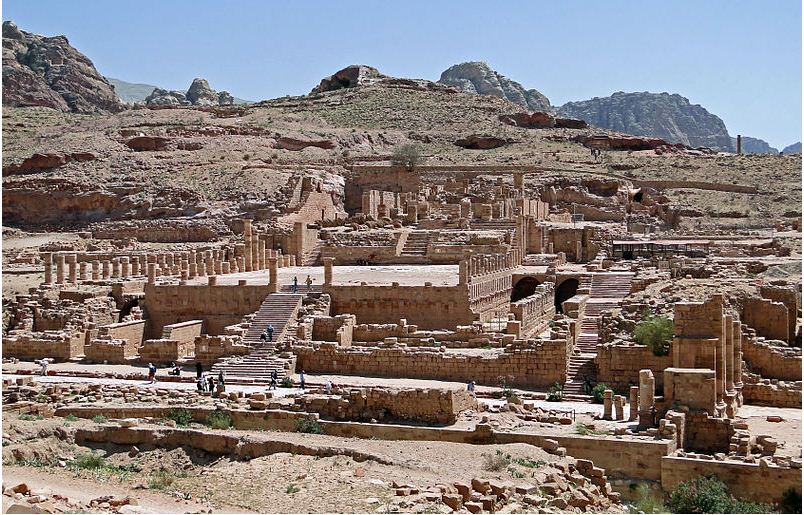The ancient city of Petra, also known as Rose-red city, is one of the most renowned archaeological sites in the world, and the greatest tourist attraction of Jordan. The towering structures of Petra, half-built and half-carved into the rock, surrounded by mountains and passages, remain as a magnificent architectural wonder of the Nabataeans. In the heart of the desert, Nabataeans built an amazing civilization with tombs and temples, aquaducts and altars, and halls and houses, and above all, the abundance and magic of ingenious waterway to provide the city with water. The breathtaking landscape covering 26,400 square meter area, situated between the Red sea and the Dead Sea, was the main caravan center for the Chinese silk, Arabian incense and Indian spices and served as an important inter-junction between Asia, Egypt, Arabia, Greece, Rome and Syria.
Location
The city of Petra, visited by millions of tourists all over the world, is located 164 miles south of the capital Amman and 84 miles north of the red sea town Aqaba, in the Arabian Kingdom of Jordan, in Western Asia. It is situated amidst the mountains to the east of a large valley connecting the Dead Sea to the Gulf of Aqaba.
The Golden Era of Nabataeans
The Nabataeans, an Arab tribe, came from the south-east Arabian Peninsula, appeared in the desert located in the east of Jordan, settled in Petra and expanded their regions. Petra was the capital of Nabataeans Empire from 400 BC to 106 AD.
The two trade routes, one from the western Asia and the other from the Southern Arabia, meet at this inter-junction. The Nabataean rulers collected taxes and the trade improved in the areas of incense, textiles, ivory, precious metals and spices. Caravans were used in the land trade and ancient sea vessels known as dhows were used in sea trade. The trade routes linked India, China and southern Arabia with Greece, Egypt, Syria and Rome.
The Nabataeans had great skill in irrigation and water technology. With their engineering expertise they collected water in pools and cisterns and distributed to the whole city using well designed engineering conduits. It is estimated that they handled about 40 million liters of fresh water per day which is capable for supplying to a modern city consisting 100,000 people.
Thus Petra offered the traders and caravans to take rest and fill their water supply needs at a fee. They controlled the trade, levied tolls for a safe business culture and became very rich and powerful in caravan trade during the third and second centuries BC. During another 400 years they expanded their facilities, beautified the city with tombs and temples, residential and commercial buildings, thus making the ancient Petra one of the wealthiest cities in the world. With the influence of Egyptian, Syrian, Roman and Greece characteristics they created structures of architectural marvel arduously cut into sandstone rocks.
The City under Roman Rule
Realizing the power of Rome, the Nabataeans made an alliance with the Romans to suppress the Jewish revolt in 70 A.D. And finally, based on a deal between Rabbel II, the last Nabataean monarch, and the Romans, the entire Nabataean empire came under the control of Roman Empire in 106 A.D. Romans redesigned the city with traditional Roman architecture, and carved many buildings and structures. Under the Roman rule, Nabataeans continued their own religious practices until 324 A.D. when the Roman Empire proclaimed Christianity as their religion. Under Byzantine Empire, Christianity continued for another 300 years showing a slow decline of the Nabataean culture.
The Lost City
In 661 A.D. the city of Petra fell under the rule of Islam and the commercial importance became completely lost. Following a series of earthquakes in 693 A.D. and later many of the buildings were destroyed and the water management systems and commercial infrastructures were demolished. After the establishment of Abbasid Caliphate in 750 A.D. the city of Petra was completely disappeared from the historical records, thus giving it the nickname of the ‘Lost City’. Faded from the memories of the West for more than thousand years, this incredible city was literally ‘rediscovered’ in 1812.
Petra Rediscovered
In 1812 Johannes Burckhardt, a Swiss adventurer set off to rediscover the lost city. Heard from the desert Bedouins about the ruins of an ancient city, Burckhardt, who was fluent in Arabic and dressed up as an Arab traveller, sought guidance of his Bedouin guide to lead him to the Lost City. After his rediscovery, this magnificent ancient city became known to the west and became one of the most visited tourist attractions of the world.
Major Attractions
With their amazing skills in architecture and engineering, Nabataeans created a city of intricately carved structures , temples, altars, banquet halls, facades and about 3000 tombs, all cut into the rose sandstone cliffs of Jordan. Few of the attractions are discussed here.
Siq: Entrance to the city is through a long passage called Siq, which can be reached by walking through ‘Bab Al Siq’ consisting of several monuments. Siq is a narrow gorge leading to the ‘Treasury’, with the widest portion measuring 5 meters, with walls standing at 100 meters high on both side and leading upwards through more than one kilometer. Many historic remnants can be seen in this entryway, including a paved road now covered with soft sand, sacred stones, colourful patterns of sandstone and sculptures of caravan of camels and men.
Treasury: Siq leads to the Treasury, which is more than 40 meters high, and is one of the magnificent structures carved out of solid rock of the mountain. Also known as al-Khazneh, the purpose of this structure is still a mystery. May be it was a royal tomb or a temple. Bedouin belief was that large amount of valuables and treasures were hidden here by pirates; hence the name treasury. The front portion of the treasury was adorned with sculptural decorations of ancient god figures. There was a 12 square meter inner chamber and a space for ritual washing.
Street of Facades: After the next turn there appears the Street of Facades, also known as Outer Siq, lined with facades of Nabataean tombs magnificently carved in the cliff of the outer Siq.
Theater: The Theater of Petra, carved entirely out of solid rock into the side of the mountain, was built by the Nabataeans in the first century AD well before the establishment of Roman rule. With a capacity of over 8000 spectators, the multi-rows of seats were separated by passageways and with stairways to ascend to the auditorium. The wall behind the stage was rebuilt by Romans. A large number of Royal tombs can be seen on the opposite side of the Theater, on the side of a valley, which is at a short walk up the hill.
Monastery: The Monastery or Al Deir is one of the largest structures in Petra and the most spectacular among all the structures. The temple is wonderfully carved completely out of red sandstone, with 45 meters high and 50 meters wide. The entrance door is 8 meter tall. The single empty chamber of 125 square meters area with plain walls is provided in the back wall with a block of stone symbolized as the deity Dushara. The main deities of the Nabataeans were Dushara, Allat and Al-Uzza. The flat courtyard in front of the temple was capable for accommodating thousands of people, indicating extensive ceremonies of those periods. In addition to the religious worship practiced by the Nabataeans, it was served as church during the Roman rule; hence the name The Monastery.
The Great Temple: The Great Temple of Petra is a two-level structure, discovered by the archaeologists of Brown University in 1992. Built in 1st century BC to 1st century AD, it was supposed to be used as a large palace and assembly hall. It is the largest free-standing building covering an area of 7560 sq.meters. The Lower Temenos, enclosed on the east and west side, accessed by stair cases and paved with hexagonal stones, are triple colonnades with a total 96 to 120 columns. Each colonnade leads to a small apse, where carving of several art crafts were found, including lamps, coins, ceramics and elephant.The proper temple is on the Upper Temenos, with walkways leading to it from the east and west. The temple is faced by a facade with four columns, and a semicircular assembly space in the center of this area.
In addition to these wonderful remnants of the ancient city, there are many more remarkable attractions that will provide magical moments to the visitors.
How to reach there
The two main international airports in Jordan are: Queen Alia International Airport (Amman) and King Hussein International Airport (Aqaba). From airport you can take taxi directly to Petra. Or from the airport you can reach Amman or Aqaba by Taxi and from there by public buses to Petra. It is a 3 hour journey by bus from Amman to Petra; and it takes 2 hours from Aqaba to Petra.
When to Visit
Petra is open to visitors daily from 6 am to 6 pm during summer and 6 am to 4 pm in winter. Best time is to start in the early morning, enjoying a comfortable stay in any one of the good hotels available in Petra.
Conclusion
This UNESCO World Heritage site was declared as one of the New Seven Wonders of the World, on July 7, 2007. Petra has been chosen by Smithsonian magazine of Washington D.C. as one of the 28 wonderful places in the world that we should never miss to see in our lifetime. The civilization that existed in Petra 2000 years ago was amazing and unique. Though capable of writing, as ascertained by the archaeologists, these people have left no written records of their mysterious era. After vanishing from the pages of history for more than thousands of years, the Rose-red city has returned, but leaving all the secrets and magic beyond the reach of time.
Image source: Wikimedia Commons
